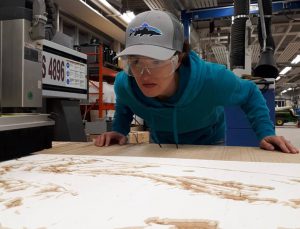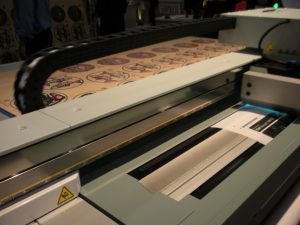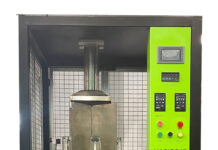 The end of the year is almost here, and your shop may be thinking of new equipment purchases either as a way to capitalize on some last-minute tax benefits or as a forward-looking plan for next year’s budget.
The end of the year is almost here, and your shop may be thinking of new equipment purchases either as a way to capitalize on some last-minute tax benefits or as a forward-looking plan for next year’s budget.
One of the big equipment purchases shops consider is a CNC router. This computer-controlled cutting machine that can handle all types of materials including wood, metals, and plastics.
Purpose & Price
“The purpose of adding a CNC router to [a sign shop’s] equipment arsenal is to expand business capabilities,” says Roy Valentine, president of Techno CNC Systems. “Many sign shops farm out the CNC router work to other companies until they see the financial benefit of adding a machine. Not only does this bring the work in-house, giving owners more control over their production and deliveries, but it saves them the money on the outsourced work.”
A CNC router is a major expense to consider and naturally the price tag will be one of the primary concerns, but shops should be careful not to “cheap out.”
“[Buying cheap] is strictly a short-term financial decision that may be more costly in the long run,” says Greg Jenkins, vice president of Sales for AXYZ International. “The downside to this decision may be lower performance, less reliability, and the limited availability of parts.”
Valentine agrees, “Buying the cheapest machine often ends in frustration as the machines are usually ill-equipped for the intended applications. Sign shops need accurate, high-quality edge finish.”
Fortunately many router manufacturers offer leasing and/or financing options as a way to help sign shops afford machines.
“[Low] monthly payments are a practical way for small shops to attain big pieces of equipment,” says Valentine. “Also a CNC router typically costs a fraction of a full-time employee and doesn’t take time off or require insurance and benefits.”
Sign shops can also look into tax benefits, such as the Section 179 Deduction, which essentially allows businesses to deduct the full purchase price of qualifying equipment and/or software purchased or financed during the tax year. Shops should always consult with an accountant for full details and limitations on any deductions.
Nuts & Bolts
When choosing a CNC router, sign companies should look for a versatile machine with a variety of cutting tools and the flexibility to cut multiple materials.
Shops should carefully consider the bed size of the router as well, to be sure the processing area fits their shop’s needs; remember too much capacity can be just as detrimental as too little.
“Buying too large of a machine with more capacity than needed is not cost-effective nor is the purchase of a router that turns out to have less-than-needed capacity. Buyers should seek expert advice,” says Jenkins.
Aside from the machine itself, sign shops shouldn’t shy away from the cost of adding on the right accessories. “A router can play a huge part in a company’s growth,” says Jenkins. “Insist on factory-employed expertise to determine the right accessories and options for the business and its applications.”
Valentine says that shops shouldn’t purchase a machine just for today—but with the future growth of their company in mind. “Adding a few miscellaneous accessories does not increase the price dramatically,” he says, “but, if added at a later date, can add significant cost because of installation fees.”
Planning for the future is important, but no one holds a crystal ball. If new technology is developed or your shop requires a new tooling accessory, your machine must keep pace with your changing needs.
“A router should be capable of evolving with advances in technology,” says Jenkins. “Insist on a supplier that can retrofit and upgrade operating systems and software on a regular basis. They usually manufacture their own routers and software without any third-party involvement.”
Planning & Placement
After choosing a CNC router, its placement in the shop is very important.
“Space required will depend on the machine size,” says Robert Marshall, vice president of Market Development for AXYZ International. “All machines will need space around them or at least space on two sides to allow for loading and unloading. A machine that is five- or six-foot wide will need at least the same amount of space on one side for safe access.
“It’s OK to place the machine against a wall on one or two sides but make sure that there is enough space for service and maintenance access. The amount of free space around the machine will also be determined by any safety systems such as light beams, mats, or fencing.”
Manufacturers will typically provide customers with plans and recommendations on placement. “CNC router suppliers will provide floor plans of their machines based on the process size and recommend floor space requirements based on production workload,” says Valentine.
According to AXYZ, these site requirements will usually also include footprint, electrical, and air requirements.
Air requirements sometimes include ventilation. “Ventilation is required for keeping control systems cool, but there also needs to be enough room for ancillary equipment such as extraction systems and vacuum pumps or blowers,” says Marshall. “Sometimes these can be sited in an adjacent room to reduce sound pollution.”
Extraction systems are important because CNC routers can generate a lot of dust and debris. “This will be minimized by the use of a correctly specified and setup extraction system,” says Marshall. “A router is an industrial machine, and so even with good extraction, it is advisable to keep it well away from printers and any other delicate equipment.”
It’s ideal to install a CNC router in its own room away from sensitive equipment like digital printers, “CNC routers produce dust that can settle on the printer heads causing operational difficulties and quality issues,” says Valentine.
Return on Investment & Upkeep
“A router that is a productive workhorse used to its maximum capacity will pay for itself over time,” says Jenkins.
Techno CNC Systems says most customers get an ROI on their machines in six to twelve months. To keep the router busy, Valentine recommends networking with other production shops (woodworking, point of purchase, general fabricators, etc.). Sign shops that may have once outsourced CNC work are now in the position to take on work as additional revenue.
“Depending on the complexity of the router work, the machine can be billed out at $150- $350/hour,” says Valentine.
A profitable machine is also one kept in good running order. Always check the user manual or with the manufacturer for any recommended maintenance and cleaning.
Still it’s a matter of when, not if, a machine goes down.
“Downtime is expensive and unacceptable for either the company or its customers,” says Jenkins. “Much of it can be attributed to time-consuming delays in securing needed parts.
“Router purchasers need to look for a supplier that operates its own online shop capable of providing spare parts preferably by the next day.”
By Ashley Bray
Photos (top to bottom): Marnie Blair; Dave Forrest.










